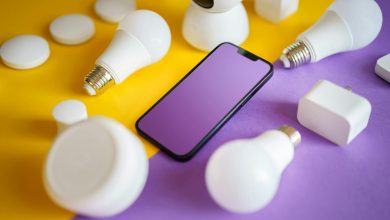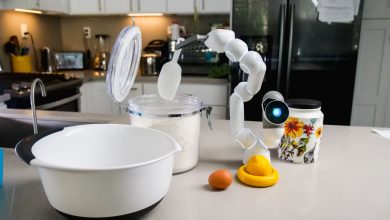10 Things I Wish I’d Known Earlier About Smart Tech and Gadgets
In today’s fast-paced world, smart tech and gadgets are everywhere, making our lives easier and more connected. But if you’re like me, you might have missed out on some of the best ones until recently. Here are ten gadgets I wish I had discovered sooner, each one bringing a little more convenience to my daily routine. From smart speakers to air fryers, these tech tools can change the way you live.
Key Takeaways
- Smart speakers can help manage your home hands-free.
- Robot vacuums save time on cleaning, letting you relax more.
- Smart thermostats can lower energy bills by optimizing temperature settings.
- Wireless earbuds provide freedom of movement while listening to music or taking calls.
- Fitness trackers keep you motivated and help you reach your health goals.
1. Smart Speaker
Okay, so smart speakers. I remember when they first came out, I thought, “Who needs this?” Turns out, I needed this. Badly. Now I have them all over the house. Here’s what I wish I knew before diving in:
- They’re not just for music. I initially thought smart speakers were just glorified Bluetooth speakers. Nope. They’re your personal assistant, news reporter, and sometimes, your therapist (when you’re arguing with it about the weather).
- The ecosystem matters. Are you an Apple person? Google? Amazon? Your choice of speaker will lock you into that world a little more. Think about what services you already use.
- Privacy is a thing. They’re always listening. It’s a little creepy, but you get used to it. Still, check your privacy settings and know what data is being collected.
- They work best with other smart devices. The real magic happens when you connect your lights, thermostat, and other gadgets. Suddenly, you’re living in the future. It’s pretty cool.
I didn’t realize how much I’d use voice commands. Now I can’t imagine turning on the lights without yelling at a cylinder. It’s efficient, if a little ridiculous.
I use mine for everything from setting timers while cooking to controlling my smart lights. It’s become such an integral part of my daily routine that I honestly don’t know what I’d do without it now. It’s probably the most used gadget in my house, besides my phone.
2. Robot Vacuum
Okay, so a robot vacuum might seem like a luxury, but trust me, it’s a game-changer. Before I got one, I was constantly lugging around my old vacuum, dreading chore day. Now? I barely think about vacuuming. The biggest thing I wish I knew earlier is how much time these little guys save you.
- Set it and forget it: Schedule it to run while you’re at work or sleeping.
- They’re not perfect: Don’t expect it to replace deep cleaning entirely, but it keeps the everyday dust and dirt at bay.
- Consider your floor type: Some models work better on hardwood, others on carpet.
I was skeptical at first, thinking it would just bump around aimlessly. But the smart navigation is actually pretty impressive. It maps out the room and avoids obstacles surprisingly well. Plus, emptying the dustbin is way easier than dealing with bags.
3. Smart Thermostat
Okay, smart thermostats. I remember when I first got one. I thought, “This is it! No more fighting over the temperature!” Well, I was half right. They do help regulate the temperature better, but there’s still some debate.
Here’s what I wish I’d known:
- Compatibility is key. Make sure it works with your existing HVAC system. I didn’t check properly and had a minor meltdown trying to wire it up. Turns out, my old system needed an adapter. Who knew?
- Learning curves are real. It takes time for the thermostat to learn your habits. Don’t expect it to magically know you want it cooler at 7 PM on Tuesdays. Be patient, and adjust the temperature settings as needed.
- Placement matters. Don’t stick it in direct sunlight or near a draft. It’ll mess with the readings and your energy bill. I put mine near a window at first, and it thought the house was always warmer than it was. Rookie mistake.
Honestly, the biggest surprise was how much I still had to tweak it. I thought it would be a set-it-and-forget-it kind of thing, but it’s more like a set-it-and-adjust-it-every-few-days kind of thing. Still, it’s better than constantly fiddling with a dumb thermostat. Plus, I can change the temperature from my phone when I’m not home, which is pretty cool.
4. Wireless Earbuds
Okay, wireless earbuds. I remember when I first got a pair. I thought, “Finally, freedom from tangled wires!” And while that’s true, there are a few things I wish I’d known before jumping in.
First off, not all earbuds are created equal. You really do get what you pay for. I started with a cheap pair, and the sound quality was… well, let’s just say I was missing out on a lot of the music. Now I know to check out expert reviews before buying.
- Battery life is crucial. Don’t just look at the advertised number. Read reviews to see what real-world users are experiencing. Nothing’s worse than your earbuds dying halfway through a workout or a long call.
- Fit matters a lot. If they don’t fit well, they’ll be uncomfortable and might even fall out. Look for earbuds that come with multiple ear tip sizes.
- Consider the case. Is it easy to open? Does it feel durable? Does it support wireless charging? These little things can make a big difference in your daily use.
I learned the hard way that sweat resistance is a must-have if you plan on using your earbuds for exercise. My first pair died a tragic death after a particularly intense run. Now I always check the IP rating before buying.
Another thing: noise cancellation. It’s amazing, but it’s not perfect. It’s great for blocking out background noise on a plane or in a busy office, but it can also make you less aware of your surroundings. Be careful when using it in traffic or other potentially dangerous situations.
5. Fitness Tracker
Okay, so you’re thinking about getting a fitness tracker? Good for you! It’s a solid step toward, well, tracking your fitness. But before you jump in, there are a few things I wish I’d known before I strapped one of these gadgets to my wrist.
First off, don’t get too caught up in the hype. They all promise to revolutionize your life, but at the end of the day, they’re just counting steps and estimating calories. It’s up to you to actually do something with that data. I remember being so excited when I first got mine, thinking it would magically motivate me to run a marathon. Spoiler alert: it didn’t. I needed to find my own motivation.
Another thing: battery life. Some of these things need charging every single day, which can be a real pain. Imagine getting ready for a hike and realizing your tracker is dead. Super annoying. Look for one with decent battery life, or you’ll end up ditching it after a few weeks. The Fitbit Charge 6 is a good option.
Don’t expect a fitness tracker to solve all your problems. It’s a tool, not a magic wand. Use it to track your progress, set goals, and stay motivated, but remember that real change comes from within.
Finally, think about what you actually want to track. Do you just want steps and sleep? Or do you need GPS for running, heart rate monitoring, and all that jazz? The more features you want, the more you’ll pay. And honestly, most people don’t use half the features anyway. I know I didn’t. I was happy with just the basics. Also, consider getting a neoprene waist belt to hold your phone and keys while you work out.
Fitness trackers are great for getting a general idea of your activity levels, but they’re not perfect. They can be inaccurate, especially when it comes to calorie counting. So, take the data with a grain of salt and don’t obsess over the numbers.
Here’s a quick rundown of things to consider:
- Battery life: Aim for at least a week between charges.
- Features: Decide what’s important to you (GPS, heart rate, etc.).
- Accuracy: Don’t rely on it for precise measurements.
- Comfort: Make sure it fits well and doesn’t irritate your skin.
6. Smart Light Bulbs

Okay, smart light bulbs. I was late to this party, and honestly, I regret it. I thought they were just a gimmick, but now I’m a convert. The ability to control your lights from your phone or with your voice is surprisingly useful.
I used to think, “Why bother?” Now, I can dim the lights for movie night without getting up, or turn them off when I’m already in bed. Plus, the color-changing options are fun for parties or just setting a mood. It’s not just about convenience; it’s about creating the perfect atmosphere.
Here’s what I wish I knew before diving in:
- Compatibility is key: Make sure the bulbs you buy work with your existing smart home ecosystem (Amazon Alexa, Google Assistant, etc.). I learned this the hard way when I bought a set that wouldn’t connect to anything.
- Consider the ecosystem: Some brands, like Philips Hue, require a hub. Others connect directly to your Wi-Fi. Think about what works best for your setup. I didn’t, and now I have an extra gadget cluttering my shelf.
- Don’t cheap out: The cheap bulbs might seem tempting, but they often have connectivity issues or don’t last as long. Invest in a reputable brand for a better experience. I tried to save a few bucks, and ended up replacing them within months.
I really like the energy-saving aspect. I can schedule the lights to turn off automatically when I’m not home, which is great for peace of mind and reducing my electricity bill. It’s a small change that makes a big difference.
I also didn’t realize how much I’d use the scheduling feature. Setting the lights to turn on automatically at sunset is a game-changer, especially during the shorter days of winter. No more coming home to a dark house! Plus, you can use smart light bulbs to create the ideal ambiance for various occasions. It’s a small thing, but it makes a big difference in my daily life.
7. Instant Pot
Okay, the Instant Pot. I was late to this party, super late. I thought it was just another kitchen gadget that would end up collecting dust in the back of a cabinet. Boy, was I wrong. This thing is a game-changer.
I mainly use mine for quick dinners after work. Throw in some chicken, veggies, and broth, and boom – dinner’s ready in like, 20 minutes. It’s also great for meal prepping. I make a big batch of rice or quinoa at the beginning of the week, and it’s so easy.
Seriously, if you’re on the fence about getting an Instant Pot, just do it. You won’t regret it. It’s saved me so much time and effort in the kitchen. Plus, clean-up is a breeze. What’s not to love?
8. Smart Plugs
Smart plugs are one of those things you don’t think you need until you have them. Then you wonder how you ever lived without them. They let you control your regular appliances with your phone or voice.
- Turn lamps on/off remotely.
- Schedule devices to power on/off.
- Monitor energy usage.
I used to think smart plugs were just a gimmick, but now I use them all the time. I can turn off my space heater from my phone when I forget, and I’ve even set up a schedule for my Christmas lights. It’s super convenient and saves energy.
They’re especially great if you’re forgetful or want to automate things like turning on lights when you’re away from home. Plus, some models track energy consumption, so you can see which devices are energy vampires. I even use one to control my coffee maker so it’s ready when I wake up. It’s a small thing, but it makes a big difference in my morning routine. Automation is the future!
9. Air Fryer
Okay, so the air fryer. I was late to the party on this one, and I kind of regret it. I thought it was just another kitchen gadget that would take up space, but I was so wrong. Now, it’s a staple.
The biggest thing I wish I knew is how versatile it is. It’s not just for fries (though it makes amazing fries). You can cook almost anything in it, from chicken to veggies to even desserts. Seriously, look up some recipes; you’ll be surprised.
- Faster cooking times than an oven
- Crispier results than baking
- Easy cleanup (most have dishwasher-safe parts)
I used to think air fryers were just hype, but now I use mine several times a week. It’s perfect for quick meals and snacks, and it’s so much healthier than deep frying. Plus, it doesn’t heat up the whole kitchen like the oven does.
I’ve found that the size of the air fryer matters. If you’re cooking for more than two people, get a bigger one. Trust me on this. A small one is fine for single servings, but it’s a pain to cook in batches when you’re feeding a family. Also, don’t overcrowd the basket; that’s the key to getting things crispy. Give the food some space so the air can circulate properly.
I’ve been using a Ninja air fryer for a while now, and I’m pretty happy with it. It’s easy to use and clean, and it cooks food evenly. I’ve also heard good things about other brands, so do your research and find one that fits your needs and budget. You won’t regret it.
10. Bluetooth Tracker
Bluetooth trackers are small devices that you can attach to your keys, wallet, or anything else you tend to lose. I wish I’d known about these sooner because they would have saved me so much time and stress. Seriously, how many times have you torn apart your house looking for your keys?
- Attach to frequently lost items.
- Use a smartphone app to locate the tracker.
- Some offer a two-way finding feature (find your phone from the tracker).
These little gadgets use Bluetooth technology to connect to your smartphone. When you can’t find the item, you simply use the app to make the tracker beep, leading you right to it. Some even show the last known location on a map.
The best part is the peace of mind they offer. Knowing you can quickly locate your important items is a game-changer. Plus, some trackers have additional features like geofencing, which alerts you if the item leaves a designated area. I’ve found Tile and Apple AirTags to be pretty reliable, but there are many options out there. Definitely worth the investment!
Final Thoughts
So there you have it, folks. Ten gadgets that could have made my life a whole lot easier if I’d just known about them sooner. I mean, who knew a smart speaker could be such a game changer? Or that a simple kitchen gadget could save me so much time? If you’re like me, always looking for ways to simplify your daily routine, I hope this list helps you find some new favorites. Don’t wait too long to grab these tech wonders. Trust me, you’ll be wondering how you ever lived without them!


